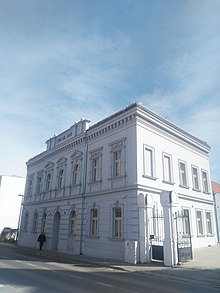| Church of St Nicholas | |
|---|---|
| Hram svetog Nikole Храм светог Николе | |
 Church of St Nicholas Church of St Nicholas | |
| 45°20′55″N 19°00′8″E / 45.34861°N 19.00222°E / 45.34861; 19.00222 | |
| Location | Vukovar, Vukovar-Syrmia County |
| Country | |
| Denomination | Serbian Orthodox |
| History | |
| Status | Church |
| Dedication | St Nicholas |
| Architecture | |
| Functional status | Active |
| Heritage designation | Register of Cultural Goods of Croatia |
| Style | Baroque |
| Administration | |
| Archdiocese | Eparchy of Osječko polje and Baranja |
Church of St. Nicholas (Serbian Cyrillic: Храм светог Николе; Serbian Latin: Hram svetog Nikole; Croatian: Hram svetog Nikole) in Vukovar is a Serbian Orthodox church in eastern Croatia. The church is one of the oldest baroque buildings of the Serb community north of the Sava River.
Architecture
St. Nicholas is nave building with an apse and bell tower at the main facade. The main front in the central part is slightly accentuated, processed by single and doubled pilasters, cornices and attic wavy line on the edges of a classicist vases. Slender tower that emphasize edge pilasters ending baroque arches with the lantern. Vaulted nave of the church is divided into four bays, which are separated by a wide archivolts resting on Ionic capitals, while the semi-dome-vaulted sanctuary. The bell tower, which was completed in 1767, is 37 meters high.
History
Present church was built in the period from 1733 till 1737. The church is built on location of old wooden church from 1690. The church was closed and looted during the World War II (1941-1942), and in 1991 interior of the church was dynamited by the local Croatian armed units in the city. Of the total 1991 pre-war internal inventory there is kept only 39 icons, 3 gospels and part of archive and church vessels. Reconstruction of external damage is completed, while the restoration of the interior is still in progress.
Inventory


St Nicholas inventory along church itself, is stated separately in Register of Cultural Goods of Croatia as a collection protected cultural property. Collection is composed of Baroque iconostasis from 1757, 17 icons from 1760, 23 books printed in Moscow in the 16th, 17th and 18th centuries - two of which are valuable octoechos from 1537, liturgical vessels, two choirs, the bishop's and the Virgin thrones, pews from the 18th century and table for communion.
Serbian Home Vukovar

The original Serbian Home (Serbian Cyrillic: Српски дом; Serbian Latin: Srpski dom) building in Vukovar was built in 1733. for the needs of the Serbian Russo-Slavic School. The original building was destroyed in a fire in 1822 in which 300 buildings in Vukovar burned.
The building was also seat of Serbian Singing Society "Javor". During World War II, the church was taken over by Nazis and Ustaše who established at as a Town Command Center. They changed building name into Adolf Hitler Home and destroyed the Serbian Cyrillic inscription Српски дом at the top of building. In the former Yugoslavia, the building belonged to Velepromet company and today it is subject to an ownership dispute between the town and Serbian Orthodox Church. Since 1991 building temporary facility religious rites until church interior will be renovated.
See also
- Eparchy of Osječko polje and Baranja
- Vukovar
- Battle of Vukovar
- Serbs of Croatia
- List of Serbian Orthodox churches in Croatia
References
- ^ Konstrukcija poslijeratnog prostora:Simbolička izgradnja Vukovara, Mateo Žanić, Institutu društvenih znanosti Ivo Pilar, POLEMOS: časopis za interdisciplinarna istraživanja rata i mira, Vol.XI No.22 Srpanj 2008.
- ^ "Ministarstvo kulture-pretraživanje kulturnih dobara". Retrieved 2013-03-30.
- ^ "Православни храмови источне Славоније, Барање и западног Срема /14/" (PDF). Joint Council of Municipalities. p. 20. Archived from the original (PDF) on 2016-02-25. Retrieved 2014-03-05.
- ^ "KULTURNO ISTORIJSKI SPOMENICI, ZGRADA SRPSKOG DOMA U VUKOVARU and -RODNA KUĆA I CRKVA U KOJOJ JE KRŠTEN ZAHARIJE ORFELIN U VUKOVARU". Consulate General of Serbia in Vukovar. Retrieved 2014-03-05.
| Serbian Orthodox Church in Croatia | |||||||||
|---|---|---|---|---|---|---|---|---|---|
| History |  | ||||||||
| Eparchies |
| ||||||||
| Monasteries |
| ||||||||
| Churches |
| ||||||||
| Education | |||||||||
| Other | |||||||||
| Orthodox Clergy |
| ||||||||
| Vukovar | ||
|---|---|---|
| History |  | |
| Districts |
| |
| Buildings and landmarks |
| |
| Places of worship | ||
| Culture | ||
| Education | ||
| Transport | ||
| Manifestations | ||
| Neighboring municipalities | ||
| Joint Council of Municipalities | ||||||||
|---|---|---|---|---|---|---|---|---|
| Municipalities and villages |
|  | ||||||
| History |
| |||||||
| Religion |
| |||||||
| Education and culture | ||||||||
| Cultural identity | |||||||||||||||||||||||||||||||
|---|---|---|---|---|---|---|---|---|---|---|---|---|---|---|---|---|---|---|---|---|---|---|---|---|---|---|---|---|---|---|---|
| National coordination | |||||||||||||||||||||||||||||||
| Regional coordination | |||||||||||||||||||||||||||||||
| Organizations | |||||||||||||||||||||||||||||||
| Media | |||||||||||||||||||||||||||||||
| Education |
| ||||||||||||||||||||||||||||||
| Religion | |||||||||||||||||||||||||||||||
| Political parties | |||||||||||||||||||||||||||||||
| Symbols | |||||||||||||||||||||||||||||||
| History |
| ||||||||||||||||||||||||||||||





